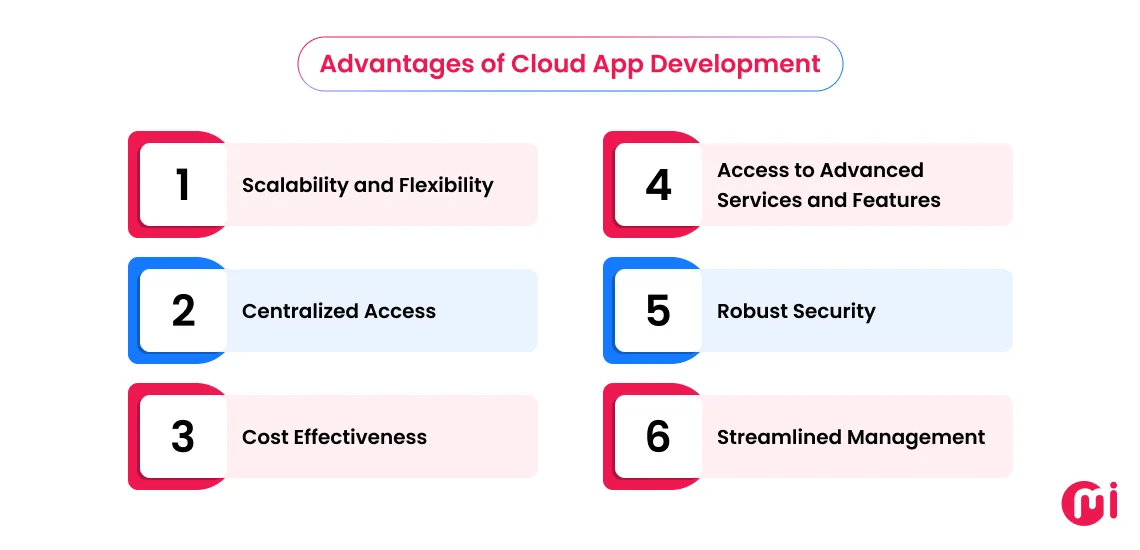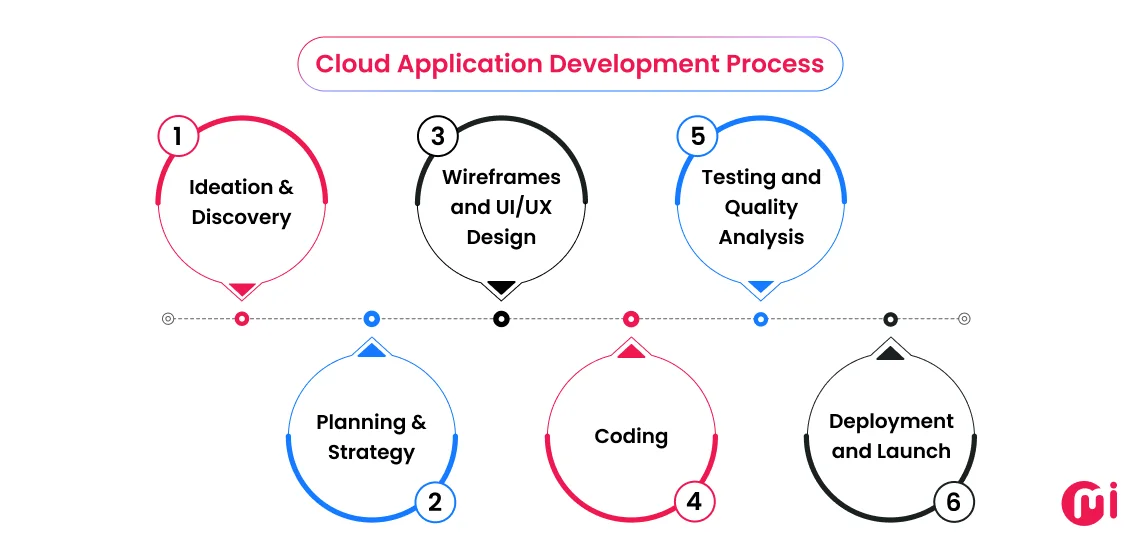Businesses in various sectors are increasingly transitioning to cloud-native solutions to enhance scalability, reduce infrastructure costs, and drive rapid growth. While the advantages of cloud computing are undeniable, creating a successful cloud application requires meticulous planning.
Selecting the appropriate type of cloud application for your business model, adopting a strategic approach to development, and managing costs and timelines are all essential factors. By aligning these elements from the outset, businesses position themselves for sustained success, avoid unnecessary expenses, and bring high-quality cloud applications to market promptly.
This article delves into the crucial considerations that matter, providing insights into various types of cloud applications, guiding you through the development process, offering a realistic breakdown of costs and timelines, and presenting compelling reasons to invest in cloud application development.
What is Cloud Application Development?
Cloud application development involves the design, construction, and deployment of applications that operate in cloud environments rather than on local servers or individual devices. These applications utilize cloud infrastructure and services to ensure scalability, flexibility, high availability, and cost-efficiency.
Cloud applications can be accessed via the internet and are constructed using models like Software as a Service (SaaS), Platform as a Service (PaaS), or Infrastructure as a Service (IaaS), depending on business needs and technical requirements.
Benefits of Cloud Application Development
Cloud application development offers several strategic advantages for companies aiming to maintain agility. Here are some ways it can support growth and enhance operational efficiency:

1. Scalability and Flexibility
Cloud-based applications can scale alongside business growth, accommodating increased users, new features, or higher workloads with instant infrastructure adjustments. This adaptability facilitates quicker time-to-market, supports expansion across regions, and ensures system resilience under pressure while maintaining operational efficiency.
2. Centralized Access
Cloud solutions enable teams to securely access applications and data from any location, facilitating remote work, enhancing collaboration, and ensuring consistency across departments and devices.
3. Cost Effectiveness
Cloud platforms operate on a pay-as-you-go model, eliminating upfront infrastructure costs and reducing ongoing maintenance expenses by charging only for utilized resources. This payment structure enhances budget predictability and enables better cost control.
4. Access to Advanced Services and Features
Leading cloud providers offer a wide array of built-in tools, such as AI, machine learning, real-time analytics, and automation, accelerating development and enhancing application capabilities without requiring additional third-party integrations.
5. Robust Security
Security is a paramount concern in cloud environments, particularly for businesses handling sensitive data, financial transactions, or regulated workloads. Major cloud providers invest significantly in enterprise-grade security infrastructure, including advanced encryption, identity and access management, compliance-ready frameworks, DDoS protection, and round-the-clock monitoring. With integrated tools and continuous updates, applications remain secure, resilient, and compliant with industry standards.
6. Streamlined Management
Managing cloud applications is more efficient and less resource-intensive than traditional systems. Automatic updates, performance monitoring, and simplified maintenance workflows reduce manual workload. Cloud platforms also offer centralized dashboards and management tools for tracking usage, optimizing resources, and ensuring real-time system health, resulting in improved operational control, quicker issue resolution, and enhanced service delivery across departments.


Different Types of Cloud Applications
The primary types of cloud applications include Infrastructure as a Service (IaaS), Platform as a Service (PaaS), and Software as a Service (SaaS). Each type serves distinct purposes based on the level of control, flexibility, and responsibility desired over the infrastructure and software stack.
1. Infrastructure-as-a-Service (IaaS)
IaaS offers on-demand access to essential computing resources such as servers, storage, and networking without the need to manage physical hardware. This model is ideal for businesses seeking full control over their application environment without investing in or maintaining on-premise infrastructure.
It supports high scalability, flexible configurations, and pay-as-you-use pricing, making it suitable for companies operating custom applications or dynamic workloads.
2. Platform-as-a-Service (PaaS)
PaaS provides a ready-to-use platform where developers can build, test, and deploy applications without managing the underlying infrastructure. It streamlines the software development lifecycle (SDLC) and handles operating systems, middleware, and runtime environments.
For businesses aiming to expedite software delivery and reduce complexity, PaaS enables teams to focus on code development and product launch while the platform manages scaling, updates, and security in the background.
3. Software-as-a-Service (SaaS)
SaaS delivers functional software over the internet without requiring installation, infrastructure, or maintenance on the user’s end. This user-friendly model is typically offered on a subscription basis.
From CRM platforms to accounting tools, SaaS applications assist businesses in quick setup, reducing IT overhead, enhancing operational efficiency, and enabling remote access across teams.
Also read: SaaS Development Guide: A Comprehensive Analysis of SaaS Development
How to Develop a Cloud Application: Step-by-Step Process
The cloud application development process involves key steps such as ideation & discovery, planning & strategy, wireframes and UI/UX design, coding, testing and quality analysis, to deployment and launch. Each phase plays a critical role in assisting in the development of a cloud application.
Here is an in-depth breakdown of each stage:


1. Ideation & Discovery
The ideation and discovery phase shape the concept into a functional and reliable model. During this stage, you are not coding or designing interfaces but rather contemplating the process and gaining clarity regarding what needs to be developed and why.
It is essential to identify the problem the application will solve, the pain points it will address for users or internal teams, and any existing gaps in current systems or workflows. Additionally, defining your goals and determining the desired outcomes, whether to enhance internal operations, introduce a new product, or create a tool supporting customers, is crucial.
The more defined your objectives, the easier it becomes to establish the app’s requirements and measure success. The discovery phase includes a comprehensive examination of your target users, the market landscape, and existing solutions, focusing on research rather than assumptions by analyzing competitors, reviewing similar tools, and identifying strengths and weaknesses.
By the conclusion of the discovery phase, you should possess a clear product vision, a list of core features, and a robust understanding of the app’s technical and business objectives.
2. Planning & Strategy
This stage bridges the gap between what you aim to build and how you will construct it. It involves aligning goals, timelines, technology, resources, and budget while outlining essential features for the application launch and prioritizing critical elements for optimal outcomes.
The planning phase entails selecting the appropriate cloud model (IaaS, PaaS, or SaaS) and cloud platforms like AWS, Google Cloud, or Azure. These decisions directly impact scalability, performance, cost, and maintenance. During this phase, defining the cloud app architecture, user roles, data flows, and system requirements is essential. This phase clarifies how each app component will function, its target audience, and the necessary infrastructure for optimal performance.
Determining the number of developers, designers, and QA professionals involved, along with the duration of each phase, key milestones, and delivery checkpoints to monitor progress and manage risks, is crucial. Creating a roadmap document detailing project scope, timelines, responsibilities, and a clear direction sets the tone for the entire development process, preventing scope creep, miscommunication, or wasted effort later on.
3. Wireframes and UI/UX Design
The wireframes and UI/UX design phase is where the cloud application truly comes to life and takes center stage. This stage defines how users will navigate the product, access key features, and efficiently accomplish tasks.
Requesting your team to create wireframes to visualize the user journey and identify usability issues early on is essential. Ensure the app’s core flow makes sense before investing time in high-fidelity designs or development. Subsequently, delineate the placement of content, buttons, forms, and menus without distractions such as color or styling. Review and refine wireframes and request a software prototype to interact with the app and its design early on.
Transition to UI (User Interface) design, determining fonts, colors, icons, branding elements, and interactive behaviors to create an attractive and functional interface. Focus on user experience design, ensuring the app is easy for users to navigate features, accessible in a few clicks, and equally well-designed for desktop, tablet, and mobile platforms.
4. Cloud-Based Application Development
This stage translates design and strategy into a fully functional cloud-based solution, divided into frontend development and backend development.
Developers construct interfaces using technologies like HTML, CSS, JavaScript, and contemporary frontend frameworks such as Angular, React, or Vue, emphasizing speed and responsiveness to ensure smooth interface operation across devices and browsers.
They address user authentication, data storage, server-side logic, third-party integrations, and other backend components of the cloud application, utilizing programming languages like Node.js, Python, or others based on project requirements.
For enterprise-level app development, teams may implement microservices, containerization, or multi-cloud infrastructure to support scalability and reliability. Throughout this phase, developers adhere to agile software development practices and iterative methods.
